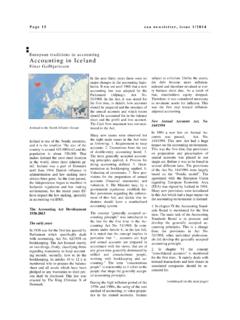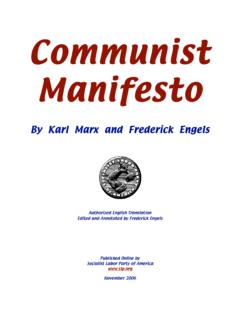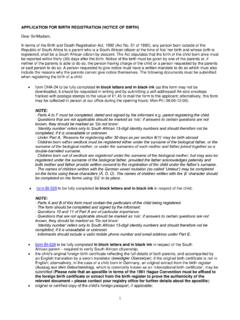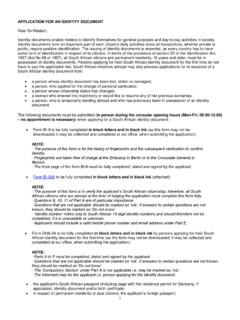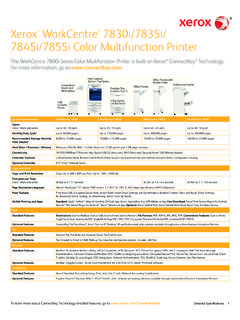Transcription of and practice1 - eaa-online.org
1 Page 20 eaa newsletter, issue 1/2013 European traditions in accounting Accounting in Denmark: The impact of business economics and practice1 Carsten Rohde Denmark is a small country in terms of both size and population, which stood at around million in the late nine-teenth century and has risen to around million today. Well into the twenti-eth century, the Danish economy was primarily based on agriculture, alt-hough the sector was to a large extent rationalised from the 1860s onwards with the formation of large coopera-tives. Commerce and industry devel-oped relatively late, and it was not until after World War I that it became possible to take a business degree that went much beyond the basics of bookkeeping. Denmark was undergo-ing a process of industrialisation, and new measurement and management tools were found necessary.
2 The establishment of Copenhagen Business School (CBS) in 1917 came to play an important role for the devel-opment of business teaching and re-search in Denmark at the time and also later. In the very beginning, two key individuals (Hans Christian Riis and Max Kj r-Hansen) were involved in the development of accounting as a field at CBS. The first of them to be employed was Hans Christian Riis, a translator who became a teacher of bookkeeping and later a lecturer of accounting at CBS. There was little teaching material in Danish, which first led to the publication of a text-book for accounting students entitled Study of the Balance Sheet and later to a book entitled Costs and Their Treatment in Book-Keeping and Cost-ing in Commercial and Industrial Companies.
3 Both books were inspired mainly by German sources, which Riis translated into a simplified form as practical knowledge to be passed on to the students at CBS. Riis also contrib-uted on the institutional front by form-ing a Commercial Knowledge Study Club with the purpose of disseminat-ing knowledge from CBS to practice and publishing the Commercial Knowledge Journal . Over time, the Club s publications turned into an especially important channel for ac-counting knowledge, and at the same time it added to the significance of CBS as the main institutional source of accounting knowledge. While at the time it was generally seen as a practical subject, in the mid-1920s the German concept of accounting as an element of more general business economics was imported to CBS through Max- Kj r-Hansen.
4 He was hired to CBS in 1924 but took leave from the School for a year in 1926 to study business economics under Pro-fessors Dr Eugen Schmalenbach and Dr E Geldmacher at the Business School in Cologne. Inspired by his stay in Cologne, on his return Kj r-Hansen wrote a textbook in Danish entitled "General Business Econom-ics", in which the concept of business economics was defined in Danish for the first time. In his book, Kj r-Hansen stresses how essential knowledge of business economics is to the running of a modern company. It no longer suffices to run a company on the basis of prescriptive rules passed down from father to son; it requires theoretical knowledge. The book builds on the terminology and ideas of the Cologne school, and in his work on accounting, Kj r-Hansen directly adopts Schmalenbach s terminology; however, he is also inspired by other German developments.
5 During the thirty years up to 1950, a Danish literature on management ac-counting evolved, based on German ideas, and for quite some time this development relied on a relatively small number of professors at Copen-hagen Business School. The growing number of works published on ac-counting was an important starting point for the next generation. Manage-ment accounting was not professional-ised in the same way as in the UK and US, as there were no professional jour-nals disseminating accounting knowledge in Danish beyond those produced by the Commercial Knowledge Club, and by the end of this period, CBS had become a centre of dissemination of the emergent man-agement accountant ideas.
6 In some ways, CBS served as a kind of stage gate through which advanced account-ing knowledge, which in this period was almost anything beyond basic book-keeping, was passed on to not only students, but also practitioners. All this development took place in a network that included prominent busi-nessmen and organisations as well as CBS, in which accounting was ex-pected not just to be an isolated sub-ject, but rather an important and inte-grated subject defined through its place and importance in business eco-nomics. (continued on the next page) Page 21 eaa newsletter, issue 1/2013 Accounting tradition in Denmark (cont d) (continued from the previous page) Accounting and business economics after WW II After World War II there was a period of adjustment to the new world order.
7 The US decided that it was necessary to assist European reconstruction di-rectly by giving aid, and in 1947 what became known as the Marshall Plan was implemented. Although Denmark emerged relatively unscathed from the war, the country did receive aid, and this was to have a direct effect on the development of accounting and busi-ness economics field from the late 1950s onwards, in particular through the work of Palle Hansen2. In 1954, Palle Hansen was appointed by the Ministry of Trade s Productivi-ty Committee to lead a Danish team on a 6-week visit to the US. This Marshall Plan-funded visit to the US seems to have reinforced the post-war tendency to look to American rather than Ger-man literature for inspiration.
8 The objective of the study visit was to con-duct technical studies of the cost ac-counting systems and budget control methods applied by American corpora-tions and, against this background, to present a report aimed at providing Danish manufacturing companies with inspiration on how to handle these issues, and thus enhance efficiency in Danish industry. When the trip was organised, it was generally acknowledged that Danish industry only to a very limited extent had started using budgeting and cost-ing methods. One of the subjects which especially required study was the function and required educational background of the controller . Hansen was particularly influenced by the then ongoing debate on the relative benefits of full costing and contribu-tion margin analysis.
9 He became con-vinced that the contribution margin method was the way forward. On his return to Denmark from the US, he immediately began organising courses in the contribution margin method for both accountants and managers, alt-hough it was some time before he be-gan to write books and articles on the subject. His courses were based on the philosophy that traditional cost ac-counting models were too sophisticat-ed for most Danish businesses, which by international standards were fairly small. His aim was to make accounting systems more flexible in order to ena-ble better control of costs and profita-bility in companies. At the same time, they should build on principles in line with those of managerial economics.
10 In addition to having an important role in management accounting, Hansen also became a dominant figure in fi-nancial accounting. Following the approach he used in management ac-counting, he advocated that the contri-bution margin method should be used in financial accounting. So through his efforts, the contribution margin princi-ple became generally used in the prep-aration of both cost and management accounts and annual financial state-ments. This changed however, with Denmark s membership of the Europe-an Community, and following the im-plementation of the 4th Directive through the Financial Statements Act of 1981, the contribution margin meth-od could no longer be used for finan-cial statements (Elling & Hansen, 1984).
